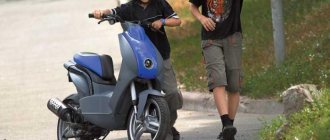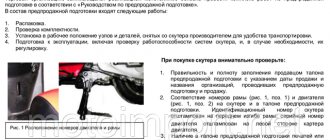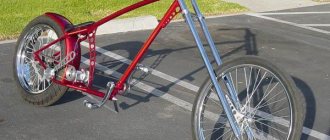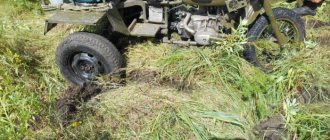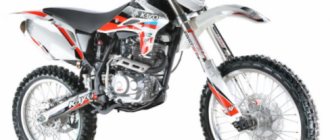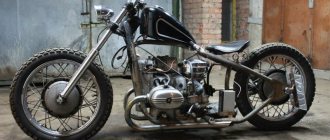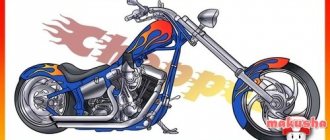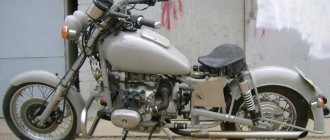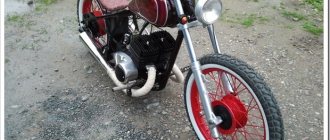The question of choosing a chopper for a beginner is often quite acute.
Of course, there are many options, but how to choose the right one? So let's look at the options for the best choppers for beginners and just beginning motorcyclists. Many novice motorcyclists are wondering about the cubic capacity. Traditionally, beginners are advised to have a motorcycle of no more than 400 cubic centimeters in volume, although this is a controversial issue. Of course, you shouldn’t jump on a powerful bike like a Kawasaki VN 2000 Vulcan or Yamaha Stratoliner right away, without experience, but don’t forget that a 600 cc or liter chopper is not at all the same as a 600 cc or liter sportbike. True, we should not forget that in the chopper class there is often a connection between engine volume and the dimensions of the motorcycle and its weight, which can be important for a novice biker. The more powerful the chopper, the larger and heavier it is likely to be.
It is worth adding that when buying an inexpensive motorcycle, you do not need to look at its year of manufacture and mileage on the odometer - you need to look solely at the condition. How to find out the mileage of a motorcycle? There are different methods described in the article at the link. But it is worth considering that it is not always possible to find out the actual mileage. But it doesn’t matter - often the age of a motorcycle and the number of its previous owners are not particularly related to its actual technical condition. It is not uncommon to find 25-year-old choppers that are in much nicer condition than 5-year-old ones.
Let's briefly look at the main options that a novice motorcyclist who is looking for his first chopper most often thinks about.
The first candidate is the Yamaha Virago in its 400 cc version:
A lightweight chopper equipped with a 40-horsepower air-cooled V-twin, two carburetors and a cardan. Structurally, it is a very simple motorcycle, which also handles beautifully thanks to its low weight, low center of gravity, short wheelbase and fairly narrow rear wheel. And the second, reserve tank under the saddle also helps to lower the center of gravity of the motorcycle.
Suzuki Savage LS400/LS650
A single-cylinder chopper with an air-cooled engine, perfect for beginners due to its flexible nature and light weight. The 400 cc version is equipped with a chain drive, the 650 cc version is equipped with a belt drive. In the 2000s, it was equipped with an injector instead of a carburetor and was named Boulevard S40. Among the features, one can note vibrations that appear at high speeds, characteristic of all single-cylinder engines.
Suzuki VS400 Intruder
Another chopper from Suzuki, very popular among beginners. Affordable and good in performance, it is equipped with a cardan drive, a carburetor power system and a V-twin liquid cooling. Very playful and dynamic for its cubic capacity, already in its factory state it is closer to a chopper than a cruiser, which is why many bikers love it. Among the features worth noting is its atypically high center of gravity for a chopper.
Honda Steed 400/600
A legendary motorcycle, beloved by customizers all over the world for its affordable price and phenomenal reliability. Liquid-cooled V-twin, chain drive, carburetor - everything is simple and intuitive. Among the differences between the 400 cc and 600 cc versions, it is worth mentioning the gearbox, on the Steed 400 it is 5-speed, and on the Steed 600 it is 4-speed. The strengths of this chopper include excellent handling and low weight, which is very important for beginners.
Kawasaki VN 400 Vulcan
Another 400 cc Japanese chopper, the best friend of a novice biker. In terms of characteristics it is close to most of its classmates, as well as in price. The peculiarity is that the dimensions are large for a 400, so this bike is worth paying attention to for tall people who will feel cramped on a Steed or Viraga. In short - a V-shaped liquid-cooled engine, chain, carburetor.
Kawasaki ZL 400 Eliminator
A kind of hybrid of a chopper, a classic and a sportbike, equipped with a derated in-line four liquid-cooled Kawasaki GPZ 400. Chain drive, 4 carburetors, more than 50 horsepower, which makes the “Eliminator” the absolute leader in power among 400 cc choppers. But its engine has to be cranked to high speeds to feel what it is capable of. However, this bike is not suitable for every novice motorcyclist.
Kawasaki EN 400
Another 400 cc chopper from Kawasaki, equipped with an in-line twin, carburetor and belt drive. A very nimble and maneuverable bike, light and pleasant to control. The engine is liquid cooled, the gearbox is, as usual, 5-speed. Everything is traditional. The bike is found on sale quite often.
Honda Rebel CMX 250
An excellent lightweight bike, unconventionally for a Honda, equipped with an air-cooled in-line twin. It has a modest size, moderate power and high reliability. Chain, carburetor Gearbox-5 - everything is as usual. As an option, it’s an excellent chopper for a girl, thanks to its lightness.
Honda Shadow 400
The motorcycle exists in different versions. In many ways it is similar to the aforementioned Honda Steed, and in terms of its technical characteristics it is practically its twin. Equipped with a liquid-cooled V-twin engine, carburetor fuel supply system and chain. It is famous for its high reliability and fault tolerance.
Yamaha XVS 400 Drag Star
One of the largest 400 cc choppers, for this reason we love tall beginners in the chopper theme, especially those who are uncomfortable on a more compact motorcycle, and do not have enough money for a larger cubic capacity. It is the epitome of a classic motorcycle design - air-cooled V-twin, cardan drive, two carburetors. Another legendary, without exaggeration, motorcycle. There are two versions - Classic and Custom.
Balaclava with skull on Aliexpress
That's probably all, or almost all, Japanese 400cc choppers for beginner bikers. We will look at Chinese choppers in a separate article.
Similar articles:
- Chopper for a girl
- Kawasaki VN 400 Vulcan
- Big choppers
- Suzuki Savage Review
- Review of OMAKS XGJ200-8 Chopper
- Chinese choppers
LiveJournal
How I built a budget electric bicycle chopper
Chopper style electric bike. Maximum speed: 56km/h. Power reserve: up to 150 km.
I'll start with the background.
I love cycling and not only cycling, but also, if possible, using this type of transport to move from point A to point B.
In February 2015, I moved to Montenegro to live for a short time, taking my bicycle with me. The city where I lived was not a flat city: there the road was either down or up. Once again dying on the climb up the mountain, I decided that I needed to do something about it. Need an electric bike! Well, let’s sit down at specialized forums and study the essence of the issue for a couple of weeks. After looking at the custom “martyr bikes” (these were a bunch of wires), I gradually drew a picture for myself of what I wanted.
1. When building, go as far as possible from the “shaheed design”.
2. Reliability and simplicity.
A little clarification: an outboard engine is not simple, in addition, the chain and sprockets need to be lubricated and they will wear out, the same goes for engines that are attached directly to the bottom bracket assembly. Although with this approach it is possible to make a transmission, which will have a beneficial effect on the dynamics of acceleration and maximum speed, but not for long. Let me explain, since perhaps not everyone is aware. The 2 simplest options are a planetarc, but they do not last long from electric motors and fall apart. The usual system, like on many mountain bikes, with several (usually 6 or more) sprockets and a derailleur, but alas, this option disappeared just as quickly, since the chain will wear out on average after 1000 km, and the sprockets will last about 3 thousand, and I'm very optimistic.
In general, the choice fell on a gearless motor wheel.
3. Pre-made space frames are good, but they remind me of dirt bikes, it's comfortable, reliable, fast, etc. But, alas, they don’t suit me yet for aesthetic reasons + considerable weight.
4. Regular cross country is also not exactly what I would like to see.
Thus, the choice fell on something like a chopper or cruiser. I thought for a long time whether to do it with depreciation or not, in the end I decided that the first project was a trial project, so there was no point in welding the frame from scratch (especially since it would cost a pretty penny), in general, I decided that I would make do with what I could find.
And so, at the beginning of summer, I returned to Odessa and decided that it was time to start.
After a short search, a Nirve Cannibal bike was purchased. Next is a kilowatt wheel motor and a standard controller for it. I’ll make a reservation: at first I wanted a 3KW MK (wheel motor), but I decided that this would be too much.
Fitting:
Preparation of the frame: it was necessary to strengthen the dropouts so that the MK axle would not turn, fortunately the frame is iron, and there were no particular problems, we just welded 8mm plates and turned them.
The photo is not so hot, but there was no other one, in general, it turned out thick:
We also had to weld the disc brake mount.
Then the search for the battery began. Ordering ready-made food directly from China was fraught with the risk of running into a low-quality product, and the price tag there was not to say that it was very tasty. Local stores are also in trouble. In general, the search for a solution dragged on for a month or two. But in the end, Li-Pol packages for 38Ah were purchased, and a 48V battery was assembled from them. Deciding to play it safe, I outsourced the assembly to guys with experience.
The result was a 48V 38Ah or 1.8KWh battery with a 60Ah BMS. 100% charged at 54.6V, controller cuts off at 42V.
The size of one cell is approximately 28cm*22cm*0.8cm. When assembling them, there should be a flat, hard dialectic between the packages; chipboard, plywood, and plastic are usually used.
It was originally assembled using chipboard, but the thickness of the finished specimen was not so great, they remade it with a different gasket (I have no idea what it’s from or what it’s called).
The battery is fitted into the case:
Case dimensions:
Now about the battery case. Many layouts, materials, and forms were tried. In the end, I settled on the option from the picture above.
I made it from 15*15 aluminum corners and (forgive my French) some crap found on the balcony. The body was redone several times, as there were some mistakes in the process. And yes, the box had to be durable, since the weight of the battery in its final form is more than 13 kg. The box is bolted from the inside, the side wall is screwed (there was an option with neodymium magnets, but it did not live up to expectations). Also, the box was additionally covered with stretch film and leatherette on top. Now, with a ready-made option, you can make it from fiberglass, if you want Feng Shui.
After preparing the box, the frame went for finishing and painting; holes were drilled in the frame, nuts were inserted and welded. Since the lower frame tube is quite close to the road by design, an additional reinforcing plate was welded to it. The protrusions of the top and bottom tube after the seatpost, on which the fender is attached, were shortened, as they prevented the wheel from sitting more deeply. The frame was powder coated. The layer turned out to be quite decent, it covered the welding areas: both modifications and factory welding, the seams are practically invisible.
Initially, brake handles with sensors were installed (when the brake is pressed, the wheel does not spin if you press on the gas) But after a short run-in, it became clear that, in principle, they were not needed, so the wires from the handles were removed (less wires - less “shahid design”) . In general, there was only one wire left on the steering wheel from the throttle trigger.
Wheels: rear 26″ with 3″ tires, front 28″ 1.75. Brakes are Tektro and Avid BB7 mechanical discs. Discs 180mm. The front sprocket is 44 teeth, the rear is 18.
Coming to the end, I will describe the test runs.
The first run was about 25 km, after 17 km the electrics failed: initially suspicions fell that the controller had overheated, since it was originally in a box with a battery, but later it turned out that the packages were simply poorly soldered together. Yes, I covered the rest of the way home on pedals, taking into account the weight of the bike (45 kg plus or minus), not the best roll (gearless MKs have such a feature), not the best ratio of stars and rider’s position, I think that everything went better Why is it good.
Later there were tests for 100 km, and they were carried out with the chain removed, so as not to spoil the final result. I would like to say that the power reserve greatly depends on driving style, headwind and the road itself. The same distance during the 100 km test differed greatly in average speed, although in both the first and second cases, at the end of the race, about 25% of the charge remained in the battery. By the way, charging takes about 3 hours.
It’s a pleasure to drive, the seating position is very comfortable, you can drive for several hours without getting tired.
By cost:
Frame (assembled bike) with modifications and painting: $600 Battery with box: $600 Motor wheel + rim + controller and every little thing: $250 Transportation costs: ~50$ Well, maybe some other little things that I don’t remember .
Well, a few more photos:
